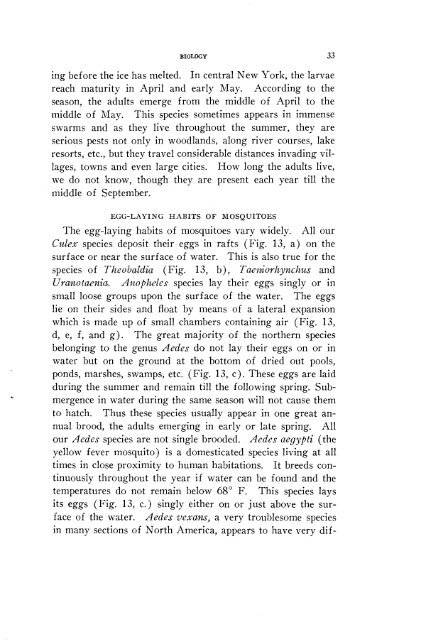a handbook of the mosquitoes of north america - Systematic Catalog ...
a handbook of the mosquitoes of north america - Systematic Catalog ...
a handbook of the mosquitoes of north america - Systematic Catalog ...
Create successful ePaper yourself
Turn your PDF publications into a flip-book with our unique Google optimized e-Paper software.
=<br />
BIOLOGY 33<br />
ing before <strong>the</strong> ice has melted. In central New York, <strong>the</strong> larvae<br />
reach maturity in April and early May. According to <strong>the</strong><br />
season, <strong>the</strong> adults emerge from <strong>the</strong> middle <strong>of</strong> April to <strong>the</strong><br />
middle <strong>of</strong> May. This species sometimes appears in immense<br />
swarms and as <strong>the</strong>y live throughout <strong>the</strong> summer, <strong>the</strong>y are<br />
serious pests not only in woodlands, along river courses, lake<br />
resorts, etc., but <strong>the</strong>y travel considerable distances invading vil-<br />
lages, towns and even large cities. How long <strong>the</strong> adults live,<br />
we do not know, though <strong>the</strong>y are present each year till <strong>the</strong><br />
middle <strong>of</strong> September.<br />
EGG-LAYING HABITS OF MOSQUITOES<br />
The egg-laying habits <strong>of</strong> <strong>mosquitoes</strong> vary widely. All our<br />
Cz~?ex species deposit <strong>the</strong>ir eggs in rafts (Fig. 13, a) on <strong>the</strong><br />
surface or near <strong>the</strong> surface <strong>of</strong> water. This is also true for <strong>the</strong><br />
species <strong>of</strong> Theobaldia (Fig. 13, b), Taeniorhynchus and<br />
Urarvzo talenia, Asop1zeZe.s species lay <strong>the</strong>ir eggs singly or in<br />
small loose groups upon <strong>the</strong> surface <strong>of</strong> <strong>the</strong> water. The eggs<br />
lie on <strong>the</strong>ir sides and float by means <strong>of</strong> a lateral expansion<br />
which is made up <strong>of</strong> small chambers containing air (Fig. 13,<br />
d, e, f, and g) . The great majority <strong>of</strong> <strong>the</strong> nor<strong>the</strong>rn species<br />
belonging to <strong>the</strong> genus Andes do not lay <strong>the</strong>ir eggs on or in<br />
water but on <strong>the</strong> ground at <strong>the</strong> bottom <strong>of</strong> dried out pools,<br />
ponds, marshes, swamps, etc. (Fig. 13, c). These eggs are laid<br />
during <strong>the</strong> summer and remain till <strong>the</strong> following spring. Sub-<br />
mergence in water during <strong>the</strong> same season will not cause <strong>the</strong>m<br />
to hatch. Thus <strong>the</strong>se species usually appear in one great an-<br />
nual brood, <strong>the</strong> adults emerging in early or late spring. All<br />
our Aedes species are not single brooded. Aedes aegypti (<strong>the</strong><br />
yellow fever mosquito) is a domesticated species living at all<br />
times in close proximity to human habitations. It breeds con-<br />
tinuously throughout <strong>the</strong> year if water can be found and <strong>the</strong><br />
temperatures do not remain below 68” F. This species lays<br />
its eggs (Fig. 13, c.) singly ei<strong>the</strong>r on or just above <strong>the</strong> sur-<br />
face <strong>of</strong> <strong>the</strong> wa.ter. Aedes vexam, a very troublesome species<br />
in many sections <strong>of</strong> North America, appears to have very dif-

















